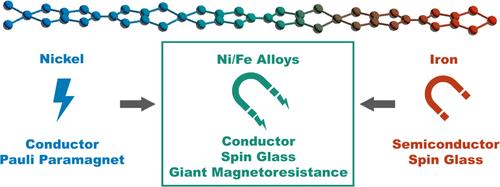Spin Glass Behavior and Giant Magnetoresistance via Aliovalent Fe/Ni Alloying in Amorphous Tetrathiafulvalene-Tetrathiolate Coordination Polymers
IF 15.6
1区 化学
Q1 CHEMISTRY, MULTIDISCIPLINARY
引用次数: 0
Abstract
The discovery of materials with programmable combinations of charge transport and magnetic properties is a major goal in synthetic chemistry. Molecular materials, such as coordination polymers (CPs), are emerging candidates in this field due to their synthetic modularity. While there are many conductive or magnetic CPs, single-component examples with both properties are still emerging. Here we demonstrate how alloying paramagnetic Fe(III) centers into a highly conductive Ni-based CP results in novel amorphous materials with high conductivity and giant magnetoresistance. Aliovalent doping with paramagnetic Fe centers engenders spin-glass transitions, while Ni and the strong π-stacking interactions of tetrathiafulvalene-2,3,6,7-tetrathiolate (TTFtt) ligands support conductivity. Ni0.69Fe0.31TTFtt has σ ≈ 200 S/cm and a 1.8 K magnetoresistance of −52% at 5 T, among the largest for any coordination solid. This work demonstrates not only how magnetic properties can be rationally incorporated into conductive CPs, but also an unexpected potential for amorphous materials in spintronic applications.

非晶四硫丁烯-四硫酸盐配位聚合物的自旋玻璃行为和巨磁电阻
发现具有电荷输运和磁性能可编程组合的材料是合成化学的一个主要目标。分子材料,如配位聚合物(CPs),由于其合成模块化而成为该领域的新兴候选材料。虽然有许多导电或磁性CPs,但具有这两种特性的单组件示例仍在出现。在这里,我们展示了如何将顺磁性的Fe(III)中心合金化成高导电性的ni基CP,从而产生具有高导电性和巨磁阻的新型非晶材料。顺磁性铁中心的银价掺杂产生自旋玻璃跃迁,而镍与四硫丁烯-2,3,6,7-四硫酸盐(TTFtt)配体的强π堆积相互作用支持电导率。Ni0.69Fe0.31TTFtt在5 T时具有σ≈200 S/cm和1.8 K - 52%的磁阻,是配位固体中最大的。这项工作不仅展示了磁性能如何合理地融入导电CPs,而且还展示了非晶态材料在自旋电子应用中的意想不到的潜力。
本文章由计算机程序翻译,如有差异,请以英文原文为准。
求助全文
约1分钟内获得全文
求助全文
来源期刊
CiteScore
24.40
自引率
6.00%
发文量
2398
审稿时长
1.6 months
期刊介绍:
The flagship journal of the American Chemical Society, known as the Journal of the American Chemical Society (JACS), has been a prestigious publication since its establishment in 1879. It holds a preeminent position in the field of chemistry and related interdisciplinary sciences. JACS is committed to disseminating cutting-edge research papers, covering a wide range of topics, and encompasses approximately 19,000 pages of Articles, Communications, and Perspectives annually. With a weekly publication frequency, JACS plays a vital role in advancing the field of chemistry by providing essential research.

 求助内容:
求助内容: 应助结果提醒方式:
应助结果提醒方式:


